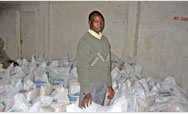You are here » Home » Telling Our Story
|
Thousands of families helped through education and treatment programs |
| Preventing Malaria Among Pregnant Women |
|
|
Malaria is common in Southern Africa (40% of all deaths in hospitals are malaria-related) and a high risk for pregnant women. Contracting malaria weakens the health of both the mother and child, and may lead to premature birth or even miscarriage. USAID is lowering the malaria rate in Malawi through several efforts that target pregnant women and children. The program helps to identify and treat the disease through training district health workers, and educating parents to seek treatment promptly.
|

|
Before
At the Zingwangwa health center in southern Malawi, each week hundreds of pregnant women wait in line for a check up. Until recently, most of them would see a nurse, but fail to receive a potentially life-saving treatment for themselves and their babies. Malaria prevention treatment was available but not widely used. Overworked nurses lacked the time and training to administer the drug. Women failed to take the pills at home, partly due to myths about potential harm to their babies.
|
| Photo: Melissa AberleGrasse |
|
|
After
Mercy, a 28-year-old mother, receives one dose of malaria-prevention treatment under the watchful eye of the nurse. Through USAID, nurses learned to educate women about the drug, explaining its importance and dispelling fears about its possible harm to the baby. After USAID's intervention, women receiving the recommended doses increased from a baseline of 29% before the program to 70% after the program. USAID support is now developing an on-the-job training manual for health workers that can be used nationwide.
|
 |
Photo: Melissa AberleGrasse
|
|
|
Print-friendly version of this page (250kb - PDF)
Back to Top ^
|


